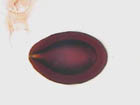Coccidiosis - Horse
| This article is still under construction. |
Description
Equine coccidiosis is an infection of the intestinal tract of equids by protozoa of the genera Eimeria. Horses may be infected by 3 species of Eimeria; Eimeria leukarti, E. solipedum and E. uniungulsti. The most common coccidial oocyst identified in equine faeces is that of E. leukarti. The prepatent period of infection by the protozoa is 16-35 days. Infection follows the ingestion of sporulated oocysts in contaminated food or water. After exposure to bile in the small intestine, the oocysts excyst and individual sporozoites emerge. Oocysts, released as the final product of the sexual reproductive cycle are shed in the faeces and are infective to new hosts. Coccidia are a common incidental findings in normal foals aged 30-125 days and suggest that this organism does not cause clinical signs in foals.
Clinical signs
Clinical signs associated with the condition occur due to the damaged intestinal epithelium and connective tissue underlying the mucosa. These may include profuse diarrhoea, weight loss, ventral oedema, intestinal haemorrhage and catarrhal inflammation of the intestinal tract.
Diagnosis
A diagnosis of coccidiosis is made by detection of oocysts in the faeces using faecal flotation. A solution of saturated sugar or sodium nitrate solution is used. Oocysts are identified by their dark brown colour and thick-walled, ovoid shape. They also contain a prominent micropyle on the narrower end.
Treatment
The treatment of choice for the disease is the sulphonamide antimicrobial agents. Sulphamethazine or Sulphathiazole are commonly used. Prevention of coccidiosis is obtained by ensuring adequate nutrition, hygiene and minimising stress.
- Only one atypical Eimeria
- Forms large subepithelial gametocytes in villi
- Large, dark coloured oocysts
- Approximately 12μm
- Occasionally causes diarrhoea
- Besnoitia bennetti in larynx of horses
- Papilloma like lesions in larynx, skin and sclera
- Thick walled parasitic cysts, covered by hyperplastic epithelium, may be ulcerated
References
- Bertone, J., Horspool, L. J. I. (2004) Equine Clinical Pharmacology Elsevier Health Sciences
- Lavoie, J. P., Hinchcliff, K. W. (2009) Blackwell's Five-Minute Veterinary Consult: Equine John Wiley and Sons
